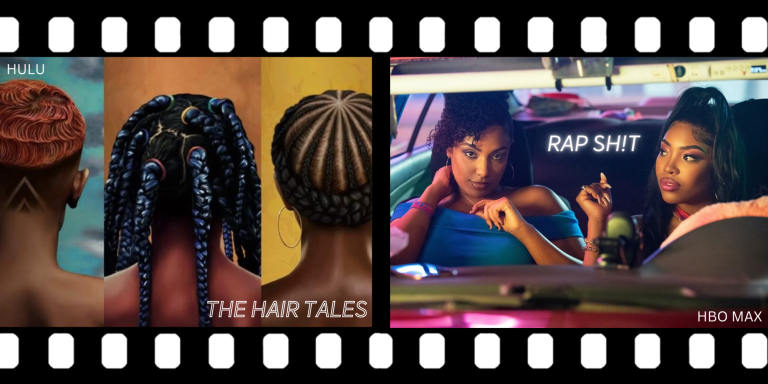The season finale of “Insecure” (2016-2021), the hit HBO series by Issa Rae ’07, was a bittersweet moment. The storytelling had come full circle, but the ending meant saying goodbye to a show that thoughtfully portrayed the lives of Black people in contemporary times.
Rae’s work over the past year, including “Rap Sh!t” and appearing in “The Hair Tales,” demonstrates her continued commitment to making content for, by and with the culture.
Another HBO production, “Rap Sh!t” is a comedy set in Miami loosely based on JT and Yung Miami’s rise to fame as the City Girls. Rae developed, executive produced and wrote several episodes. The show centers on high school friends, Shawna (Aida Osman) and Mia (KaMillion), who reconnect and form a rap duo. Beyond depicting the challenges of succeeding in the music business, the series highlights the difficulty of climbing the economic mobility ladder in the digital hustle culture era.
The audience is introduced to the characters through the frame of social media, where we learn the ABCCs of digital hustle culture: always be creating content. From Instagram reels to stories to livestreams, the sharp cinematography and direction evoke the feeling of being very online.
On the show, being a multihyphenate is not necessarily indicative of virtuosity. Instead, it reflects the reality that working class individuals must juggle multiple jobs to make ends meet.
Shawna holds down a day job as a front-desk attendant at an upscale hotel where she takes orders from (and scams!) entitled patrons. Scamming supports her art and she uploads rhymes as her masked alter ego, The Vision. As a socially conscious rapper, Shawna refuses to cash in on a sexy image because she wants people to focus on her music. Her career has stalled — until she links up with Mia.
Mia is a young mom who works three jobs and navigates raising her daughter with an affable, albeit unreliable, co-parent. Mia isn’t as socially advantaged as Shawna, but she understands better how the world works. In her pithy influencer videos, she advises women on the importance of making sure romantic relationships are financially beneficial.
She is also a makeup artist; during an Instagram live where she is helping a young white woman get ready for a wedding, the bridal party begins to riff on her vernacular. Although it is all in good fun, the scene sheds light on Mia as a cultural worker whose creative contributions are frequently appropriated, but never quite replicated with the same panache.
The rise of female rappers signals a brand of Black cool that is primarily conveyed by women. “Rap Sh!t” explores the broader implications of image-making as Mia and Shawna navigate creative differences.
From their very first studio session, Shawna wants to make music that is relevant to people’s lives, but Mia questions why fun, sexy music isn’t relevant. In addition to finding Shawna’s civil rights socialist bars corny, Mia points out that we’re in a “bad bitch renaissance” where female rappers are avatars who say things the average woman thinks but may not have the language to express. Mia triumphs by pointing out that letting men’s opinions dictate the kind of art you make is acquiescing to male domination.
However, a battle won doesn’t mean the war is over, and this tension unfolds throughout the season. Shawna adopts a baddie aesthetic, but there are subtle clues that changing her external appearance doesn’t curb her impulse to rhyme with reason. Things come to a head in a climactic scene in the second half of the season, which indicates that Shawna may have traded the mask she wore as The Vision for another disguise. Seeing Shawna reject the right time and place to switch up her flow may be frustrating — but why be bad if you can’t be real?
Similar to “Rap Sh!t’s” exploration of Black female interiority and creativity, Rae’s episode of “The Hair Tales” explores how her hair journey has affected portrayals of Black women in her work. Developed by Tracee Ellis Ross and journalist Michaela Angela Davis, each installment of the docuseries features Ross interviewing a Black female celebrity.
In her episode titled “Powerful Versatility,” Rae describes becoming the object of ridicule in her predominantly Black middle school for donning her hair in its natural state. Since the Black popular culture icons in the late ’90s largely sported straightened flowing hair, Rae’s kinky curls were denigrated as “nappy.” The immediate cut to a beauty shop scene provides various perspectives on the multivalent cultural connotations of the word “nappy.” One interlocutor explains it was used to refer to the nap of leather and is inadequate to describe hair texture. When the episode returns to Rae, she discusses intra-community standards of beauty and how her mother’s example helped her come to terms with loving her own natural hair.
Although several episodes detail the pressure to achieve normative Eurocentric beauty standards, Rae’s episode is a standout. She reflects on using her art to depict the versatility of Black hair and by extension, the complexity of Black women’s lives. While hair is sometimes a window into how a character is feeling and a vehicle for self-expression, the most radical thing is that instead of being framed as problematic or burdensome, Black hair is just hair.
Media shapes reality, and Rae seeks to create new worlds by producing culturally specific narratives that resonate with a wide audience.
Editor’s Note: This article is a review and includes subjective thoughts, opinions and critiques.
